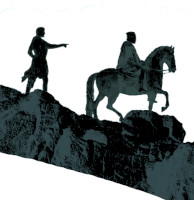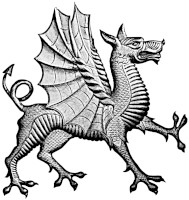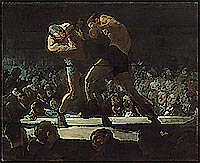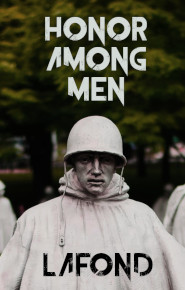Shared Traditions
Every one of the 12 House Munera, or Funerary Orders, as all members are sworn to die in service to their order, has its own traditions and functions. All orders share the following:
-A. All members, from the fresh orphan Trainee in far Oceana to the Bishop of the Great House of the Order in London, are slaves, owned by The House.
-B. SPQR is branded on the right shoulder above the house brand.
-C. The back from shoulder to shoulder is branded with the imprint, “Sworn to Die for Christ.”
-D. All habits consist of sleeveless linen tunics, trousers and soft un-heeled boots. All over garments must be of cotton, canvas and or wool, all sleeveless, from vest, to cloak, no part to be made of leather or animal hides, satin or silks.
-E. No gladiator may ride a horse, not even the Knights Equis.
-F. All gladiators wear the manica as their basic civic, military and religious equipment. The manica is a fingerless glove made of Saracen or heathen skin over which are layered overlapping brass [lorica segmentata] plates extending to the elbow, which is capped in a brass boss. These are laced with heathen or Saracen sinew. These my only be removed within a warded habitation blessed by a bishop, priest, chaplain, deacon or presbyr.
-G. The traditional weapons with which all gladiators train as Tiros are the manica [a wool and tin version used in school], the rod, a stick of 3 feet in length and an inch in thickness, the gladius, or Spanish sword, a straight double edged cut and thrust blade 2 feet from pummel to point, the pugio, or dager, and the shield or buckler.
-H. The traditional arms of each house are those used in antiquity, which are only employed for religious duties and arena combats.
-I. Arena combats between houses are fought to disarm or submission, unless chaplains of both contending houses have declared a Holy trial by combat. Survivors of Holy trials are branded on the right arm with a sword and nimbus. Death matches in the arena [the sands] are typically barred between Christians and reserved for Carnival events pitting captive Saracens, heathens and heretics against Christian champions.
-J. All arenas are consecrated ampitheaters built around a 32 foot circle of sand, at the center of which is a 16 foot iron crucifix wound with barbed steel wire to prevent its defensive use. Each House has an arena. The Public House of every censor of a Roman town or city is also built around an arena.
-K. All arena combats are attended by three figures, two flail bearing lanistas, each assigned to punish one of the combatants and a Saracen, Negro or Chinese eunuch who keeps time with a brazen maul and gong.
-L. Formal and mob naming conventions coexist in the identity of a Gladiator. Famous gladiators, such as Max and Rex Born have fame that exceeds their muneral identity. Before such fame was earned, Max was formally addressed in clergy, muneral and government context as Max [Name] Thrax [House]. However plebes and mobsters might address him as Max Scott, The Thracian or Highlander Max. His brother Rex was formerly Rex Equis and popularly Rex Knight while his detractors named him The Sarmation, as he was the physical wonder of his kind. For the purpose of clarification we will suppose that Joe the Plebe is imagining himself as a gladiator, and will end the description of each house with his formal address and then popular and even mob address.
…
House: Secutor or Chaser
Rank: 7th
Sacral Month: Mary, Mother of God
Patron Archangel: Michael Defender of the Faith
Guiding Apostle: Thomas, Witness to India
Bloodline: Gaelic, Irish preferred
Colors: Green
Brand: Celtic Cross
Religious Duty: Defend and Avenge Lay Clergy [Deacons and Presbyrs]
Military Duty: Coast Guard, Boarder Patrol, Scouting
Civic Duty: Recover Runaways
Traditional Arms: Large Shield, Half Sword, helmet
Military Arms: Half Sword, 3 pistols, “slade” or steel hat
Civic Arms: same as military
History: In 1531, instituted to ward the coasts from Norse and Saracen raiders.
Glory: The entire order save a lone tiro orphan named Patrick, perished in 1602 taking Iceland from the Danes.
Joe Secutor, or Joe Chaser, the name of one’s house essentially one’s sir name.
…
House: Dimacherius or Welshman or Knifeman
Rank: 8th
Sacral Month: Nativity
Patron Archangel: Michael Defender of the Faith
Guiding Apostle: Simon the Cananean
Bloodline: Gaelic, Welsh preferred
Colors: forest green
Brand: Mountain within a halo
Religious Duty: slay and or capture heretics and Saracens for inquisition
Military Duty: scout, raid and skirmish
Civic Duty: spying
Traditional Arms: two long knives
Military Arms: carbine and long knives
Civic Arms: knives and hooded cloak
History: Welsh orphans and criminals were formed into a house in 1603 in order to defend Iceland and infiltrate Greenland.
Glory: The order distinguished itsself by taking the isle of Gomera from the Saracen Moors in 1671.
Joe Dimacherius [1] or Joe Welsh or Knifeman Joe or even Welshy Joe
-1. ancient term meaning “double cleaver fighter”
…
House: Sagisarius or Archer or Cupidius
Rank: 9th
Sacral Month: Conception
Patron Archangel: Uriel and the Lesser Angels or Cheribum
Guiding Apostle: Judas Iscariot
Bloodline: Pannonian Christians, Native Tribesmen of the New World
Colors: Red with Black trim
Brand: Crucifix with Dream Catcher as a Nimbus
Religious Duty: Bring Heathen sorcerers to Church Officials for conversion or Arena trial
Military Duty: scouting and recovering deserters
Civic Duty: hunting and recovering runaways
Traditional Arms: Bow and arrows, tomahawk and knife, red head scarf with a feather for every kill [bows are not used in arena combats]
Military Arms: same as military
Civic Arms: same traditionally employed in rural settings, not cities and towns, where secutors fill runaway and deserter recover rolls
History: Beginning in 1675, Praying Indians were raised in New England to battle their demonic cousins of the woods and are feared world wide for their tenacity as manhunters.
Glory: Seventy Mohawks of the House Sagisarius, in the year 1804, landed near Fez in Morocco to recover six nuns held in the Atlas Mountains by a Muslim Iman. In 1807, three of their number appeared in South Africa at a Zulu Kraal allied with Rome, with one of the nuns rescued, virginity in tact.
Joe Sagisarius or Joe Archer or Cupid Joe, with plebes and patricians tending to put Joe first and mobsters, sailors and soldiers tending to place the function before the person in Cupid Joe.
…
House: Bestiarius or Huntsman or Hunter or Ranger, usually one of the latter in Pannonia
Rank: 10th
Sacral Month: Decline
Patron Archangel: Raphael
Guiding Apostle: Thaddeus
Bloodline: Breton, Gaelic or any Christian convert from among the heathen tribes or the Germanic or Nordic races
Colors: brown
Brand: long rifle
Religious Duty: providing meat for Carnival
Military Duty: scouting, sniping runaway recovery
Civic Duty: hunting, law enforcement in wilderness and frontier territories as agents of the territorial Lictor, beast hunts with pistol and knife in urban arenas, generally the mob favorite.
Traditional Arms: half inch bore flint lock rifle, pistol, knife, slouch hat
Military Arms: same as traditional
Civic Arms: same as traditional
History: First instituted as rangers in New England by senatorial colonists in the 1600s, and organized into a formal house in 1754 after the Wyandot War.
Glory: In 1922, 12 rangers of the Mussel Shell House, held off the last large scale raid by heathen tribesmen against great odds, effecting the conversion and recruitment of Northern Plains warriors into the Sagisarius Houses of Oceana, so important for the conquest and conversion of those many isles and the Empire of Japan.
Joe Bestiarius or Joe Huntsman [patrician/military officers] Joe Hunter [plebean] or Ranger Joe [mobsters, soldiers and sailors]
…
House: Pugilarius or Boxer or Fistic
Rank: 11th
Sacral Month: Advent
Patron Archangel: Raphael
Guiding Apostle: James Alphaeus
Bloodline: any race accepted
Colors: blue streaked with red
Brand: fist and gauntlet crossed within a halo
Religious Duty: bodyguards to bishops, cardinals
Military Duty: physical trainers, medics and entertainers
Civic Duty: entertainers, body guards to senators, censors and tribunes
Traditional Arms: cestus, being a heavier gauntlet than the military manica, some times spiked or barbed for death matches
Military Arms: heavyweights use heavy shields for protecting commanding officers while lighter fighters work as medics, treating and retrieving wounded soldiers and sailors
Civic Arms: standard manica
History: In 1899, Father O’Neal of the South Pannonian fleet instituted gloved boxing as a physical fitness regimen, causing Augustus Britannicus, called “Arthur Twelve” to institute the House Pugilarius in 1902.
Glory: Lightweight Champion of New York, Brett “The Dart” Swanson, recovered 32 wounded sailors at the battle of Oki Island in 1941.
Joe Pugilarius or Joe Boxer or Fistic Joe
…
House: Rudiarius or Rodman or Stickman
Rank: 12th
Sacral Month: Fall
Patron Archangel: Gabriel Messenger of God
Guiding Apostle: Mathew the Tax Collector
Bloodline: any
Colors: two ivory rods
Brand: crossed sticks
Religious Duty: defend Cathedrals, churches, nunneries and other church centers at the command of the Bishop, who has direct command over the local chaplain and in London, the Bishop of Rods.
Military Duty: military police
Civic Duty: train the Lictors
Traditional Arms: two ivory [usually whale bone] rods, open faced helmet
Military Arms: one rod and fetters, helmet
Civic Arms: one rod and fetters, helmet
History: Instituted by the admiral of the Oceannic Fleet in 1932 and ordained under the Pope and Augustus in 1940, Rodmen are the least liked by the plebes, hated by the mob and slaves and resented by soldiers and sailors. Their arena bouts are typically with unrepentant criminals. They are natural allies of the Lictors and themselves resent the Praetorians, who often involve themselves in civil disorder.
Glory: Arn Rodman, a Nordic convert to the order, once defeated the champion of the Augusta Praetorians in a trial by combat over mob dispersal jurisdiction, in which he disarmed the armed swordsman with his whalebone rods.
Joe Rudiarius or Joe Rodman or Stickman Joe











